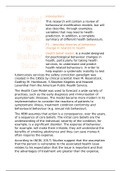Introduction:
Model This research will contain a review of
behavioural modification models, but will
s of also describe, through examples,
variables that may lead to health
Healt
prediction. In addition, a complete
summary of different health behaviours.
P1 – describe theories of behaviour
h change in relation to health
Health belief model: is a model designed
Behav for psychological behaviour changes in
health, particularly for taking health
iour services, to understand and predict
health-related behaviours. In order to
help explain a systematic inability to test
tuberculosis services the safety conviction paradigm was
created in the 1950s by clinical scientist Irwin M. Rosenstock,
Godfrey M. Hochbaum, S.Stephen Kegeles and Howard
Leventhal from the American Public Health Service.
The Health Care Model was used to forecast a wide variety of
practises, such as the early diagnosis and immunisation of
asymptomatic illnesses. The model became more modern in its
implementation to consider the reactions of patients to
symptomatic illness, treatment condition conformity and
behavioural behaviour (e.g. sexual risk behaviour).
The HBM assumes that action is a consequence, over the years,
of a sequence of core beliefs. The initial core beliefs are the
understanding of the individual; severity of the condition, for
example, is a significant disorder. The expense of behaviour,
for example, will make them irritable, they will understand the
benefits of smoking abstinence and they can save money It
often requires the expense.
According to (NCBI, 2017) Studies suggest that the assumption
that the person is vulnerable to the associated health issue
relates to his expectation that the issue is important and that
the advantages of treatment are greater than the expense,
, with respect to dietary conformity, protection, vaccines,
frequent dentistry visits and the daily practise programmes.
The model of health beliefs emphasises that tobacco usage
relies on the expectations of a individual about; specific burning
of tobacco diseases, the severity of tobacco as an concern, the
expense and effectiveness of care (for example, value of
action), the obstacles to stop-growth and the challenges to
change tobacco usage.
Perceived susceptibility – the reported risks that cigarette
consumers experience diseases linked to smoking, such as lung
cancer, CVD, oral disease, miscarriage, etc.
Perceived severity – tobacco consumers' conviction on the
severity and effects of the specific smoking situations.
Perceived benefits - The presumed benefits relate to one's
belief that the prescribed health activity is successful in
mitigating harm or severity.
The Stages of Change Model –
The theory was presented that people go through 6 (five)
phases of behavioural improvements fairly distinguishable. The
main characteristics of the phases of change are conscious
action motivation, shifts in viewpoint as a mechanism instead
of as an occurrence, a cycle of change characterised by a
sequence of phases of change and the desire to improve a
person's actions across these phases of improve





